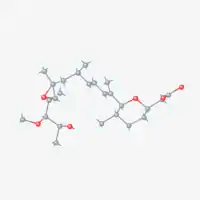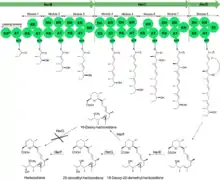Herboxidiene
Herboxidiene is a polyketide molecule soluble in polar solvents such as water, ethanol, n-butanol and acetone but insoluble in non-polar molecule such as hexane. It was first isolated from the fermentation broth of Streptomyces chromofuscus by researchers in Monsanto Company in 1992.[2] Herboxidiene shows in vitro antitumor activity by targeting the SF3B protein in the splicesosome.[3] Many antitumor derivatives have also been developed from herboxidiene through chemical modification.[4]
 | |
 | |
| Names | |
|---|---|
| IUPAC name
[(2R,5S)-6-[(S,1E,3E)-6-{(2R)-3-[(1R,2R,3R)-3-Hydroxy-2-methoxy-1-methylbutyl]-2-methyl-2-oxiranyl}-1,5-dimethyl-1,3-hexadienyl]-5-methyltetrahydro-2H-pyran-2-yl]acetic acid | |
| Identifiers | |
3D model (JSmol) |
|
| ChemSpider | |
PubChem CID |
|
| |
| |
| Properties | |
| C25H42O6 | |
| Molar mass | 438.605 g·mol−1 |
Except where otherwise noted, data are given for materials in their standard state (at 25 °C [77 °F], 100 kPa). | |
| Infobox references | |
Structure
Compared to other polyketide compounds, herboxidiene has a unique epoxide functional group. This structure results a relative low yield in the chemical synthesis of herboxidiene as the epoxidation usually accompany with other oxidized products such as ketones, carboxylic acids and aldehydes.
Multiple chiral centers are another bottleneck in the chemical synthesis of herboxidiene. There are nine chiral centers in the herboxidiene molecule and stereoselective methods are necessities of herboxidiene synthesis.
Biosynthesis
Biosynthesis of herboxidiene has been studied for over 20 years since its discovery. The precursor of herboxidiene, 18-deoxy-25-demethyl herboxitriene was first synthesized in Streptomyces chromofuscus through a nine-modules PKS I pathway. 18-deoxy-25-demethyl herboxitriene is then epoxidized by enzyme HerE on the carbon carbon double bond between C14 and C15, oxidized by enzyme HerG on C-18 and eventually methylated by enzyme HerF on C25 to herboxidiene with the help of cofactor SAM.[5]
 Biosynthesis of Herboxidiene in PKS I pathway
Biosynthesis of Herboxidiene in PKS I pathway
Anti-tumour mechanism
Herboxdiene suppresses the growth of tumor cells by interfering the splicing of pre-mRNA coding for cell cycle regulation proteins in our body. The target of herboxidiene was discovered in 2011.[6] In their research they discovered GEX1A (Herboxidiene) can bind with SAP155, one of the seven spliceosome-associated proteins that consist splicing factor SF3b. By binding SF3b, herboxidiene can trigger accumulation of both protein p27 and its C-terminus truncated version p27*. p27 and p 27* are important proteins that regulate cell cycle of mammalian cells. Accumulation of p27 and p27* result in the inhibition of cells from entering G1 and S phase of the cell cycle and therefore can contain the growth of tumor cells.
References
- "HERBOXIDIENE (CAS No. 142861-00-5) Suppliers @ ChemicalRegister.com".
- M. Wideman, N. Makkar, M. Tran, B. Isaac, N. Biest and R. Stonard "Herboxidiene, A New Herbicidal Substance from Streptomyces Chromofuscus A7847", The Journal of Antibiotics, November 16th, 1992
- "Spliceosome Modulators as Antitumor Lead Compounds".
- Arun K. Ghosh, Kai L, Nianchun M, Emilio L. Cárdena, Kerstin A. Effenberger and Melissa S. Jurica, "Design, Synthesis and in vitro splicing inhibition of desmethyl and carba-derivatives of herboxidiene", Organic and Biomolecular Chemistry, April 6th 2016
- A. Raj Pokhrel, D. Dhakal1, A. Kumar, Jha and Jae Kyung Sohng, Herboxidiene biosynthesis, production, and structural modifications: prospects for hybrids and related polyketides, Applied Microbiology and Biotechnology, October 2015 Volume 99, Issue 20
- "Makoto Hasegawa†, Tatsuhiro Miura†, Kouji Kuzuya†, Ayu Inoue†, Se Won Ki‡, Sueharu Horinouchi‡, Tetsuo Yoshida§, Tatsuki Kunoh†, Koichi Koseki†, Koshiki Mino†, Ryuzo Sasaki†, Minoru Yoshida∥, and Tamio Mizukami†, "Identification of SAP155 as the Target of GEX1A (Herboxidiene), an Antitumor Natural Product", ACS Chemical Biology, 2011, 6 (3), pp 229–233 DOI: 10.1021/cb100248e Publication Date (Web): December 07, 2010